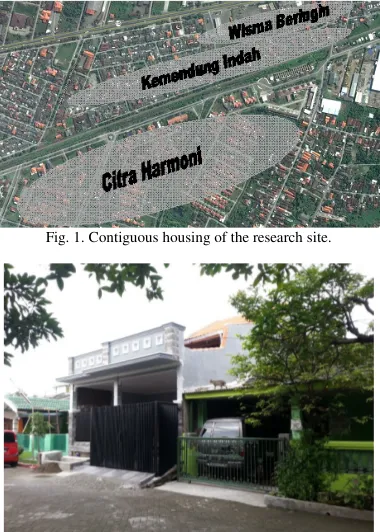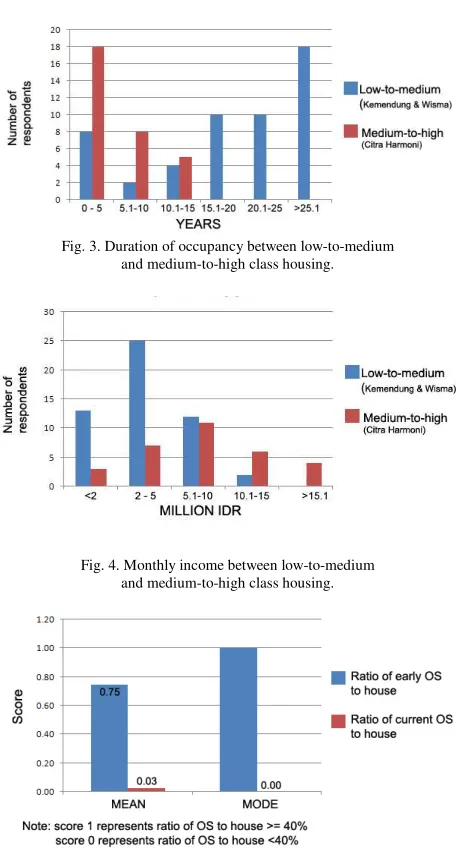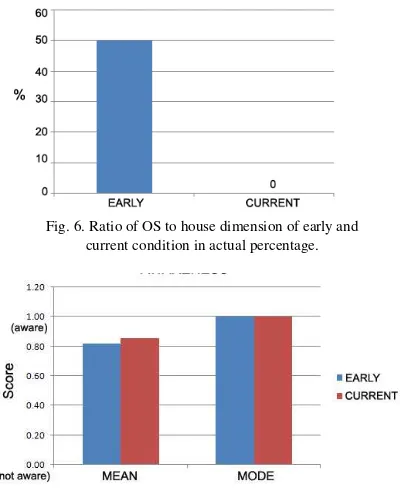Abstract—Non-proportional ratio of built area and
open space on house-lots in housing district is suspected a trend in Indonesian housing. Several contiguous housing in Sidoarjo Regency, Indonesia, comprises of low-to-medium and medium-to-high class housing was studied to learn on the trend. It concluded that 100% respondents were significantly proven to have insufficient private open space toward 0%. The study proved that respondents possessed sufficient awareness but limited knowledge on the necessity of private open space.
Index Terms— Awareness, house-lot, knowledge, open space.
I. INTRODUCTION
Demand on more and bigger room within house has triggered house-owner in many places in Indonesia to extend their house both horizontally and vertically. However, unprepared building sub-structure to bear additional upper structure of two-storey or more buildings leads to horizontal extension as a trend. Horizontal house extension on a limited house-lot has resulted insufficient open space (OS). This seems a trend in Indonesian house-lots. The trend was suspected caused by limited awareness and knowledge among house-owners on the necessity of green OS or simply OS around houses.
House with sufficient OS will gain many benefits, such as day-lighting and natural ventilation for most of its inner rooms. Moreover, when the OS is green, it will also provide absorption bed for rainwater harvesting which is constantly redundant during rainy season in Indonesia. House surrounded by walkable green OS would also benefit on senior citizen longevity [1]. House without sufficient OS has significant contribution to the presence of local puddle. When houses with insufficient OS are majority in a housing region, the puddles are likely become flood.
Issue and discussion on green OS or simply OS within private property is very limited. We mostly discuss on the necessity of public green OS and slightly disregard the benefits of private green OS or simply OS. A green OS on a private lot is never been bigger than that of public OS. But, multiple effects of this insignificant dimension will play a
Manuscript received February 21, 2014. This work was fully supported by Petra Christian University, Surabaya, Indonesia.
C.E. Mediastika is with Department of Architecture Petra Christian University, Indonesia 60236 (e-mail: eviutami@petra.ac.id).
role on the availability of sufficient OS throughout urban region. That is, a research to study the main cause on the absence of private OS is reported here.
II.OBJECTIVE
The study was aimed to learn on how house extension toward zero OS was existed. In detail the study would see whether correlation among house extension, duration of occupancy, economic class or income, awareness and knowledge on the necessity of private OS are existed. The finding will be utilized to educate younger generation on the importance of OS through informal classes.
III. THEORETICAL APPROACH
Study by Lacy [2] has reported that clustered houses with protected OS were appreciated higher by market than those of single conventional housing with larger private yards. This case might not be similar to that of Indonesia. Indonesians seem more appreciate housing region with sufficient yards or public open spaces. Trend difference between Lacy’s statement and the Indonesians is supported by Connel and Walls [3], who revealed that OS values are case study–specific. Particular OS area or set of areas is unique to a particular region and time period. However, as a general term, notions of beneficial effects of nearby green space have persisted throughout history, especially to improve people's health and well-being by providing restoration from stress and mental fatigue [4]. A research comparing residents with a view of urban greenery to residents without such view showed that those with view gain better well-being [5]. Moreover, a research has shown that views of nature can improve feelings of neighborhood safety and even lead to decreases in aggression and crime rates [6] and [7]. With these benefits, it is expected that house-owners are aware and possess knowledge on how OS shall be provided within house-lots. Awareness and knowledge is expected to be effective instrument to fix this trend.
Trend on the Absence of Private Open Space in Several
Contiguous Housing in Sidoarjo, Indonesia
Christina Eviutami Mediastika
Fig. 1. Contiguous housing of the research site.
Fig. 2. Houses in Kemendung Indah Residence with full-front roofing. The roofs exaggerates on to the street kerb side.
IV. METHODS
The study was conducted as quantitative field survey. Questionnaire was developed as an instrument to collect the data. Respondents were limited to house-owners of several contiguous housing in Sidoarjo, Indonesia. It was Wisma Beringin, Kemendung Indah and Citra Harmoni (Fig. 1 and Fig. 2). The first two housing was plotted representing low-to-medium class housing, whilst the third was for medium-to-high class housing. The housings were selected based on the constant issue of the existence of local puddle during rainy season. Borderless-contiguous mixed of low-to-medium and medium-to-high class housings was also an issue to determine the research site. Richness of housing types will benefit the study to learn whether monetary factor exists toward decision on extending the house.
Likert’s scale questionnaire is the most common method to study on people’s judgment. Likert’s scale is a widely used scaling to measure people’s judgment on such issues. It usually ranges from “strongly disagree” to “strongly agree” on such issues. It is scored from 1 to 5 or 1 to 7 for more detail. One is scored for those who “strongly disagree” and 5 or 7 are for those who “strongly agree”. However, in this study, the questionnaire could not be constructed using the common Likert’s scale fully. As this study was not merely learning on people’s judgment, but also on the causal effects of an action, the Likert’s was modified to fit the expected data. The questionnaire was developed as close as possible to the Likert’s scale.
There were dependent and independent variables appointed to construct the questionnaire (Table 1). Dependent variable was extended house on the house-lots, whilst the independent were duration of occupancy, monthly income, and early and current awareness and knowledge on the necessity of green
OS. These variables were generated within a set of questions. As the knowledge background of respondents are various and as the questionnaire was self-filled by respondents, the options of answer in the questionnaire were designed to offer ease in picking the answer. A comprehensive instruction on how to fill and pick answers was written prior to question lists. Self-filled method was selected upon time availability of the respondents. Most respondents spend their time working elsewhere and thus enumerators have very limited time to conduct interview. That is, self-filled method was considered more appropriate to gain as many as possible respondents. Checking for errors or bias answers were carried out during questionnaires collection, so as to be directly confirmed to the associated respondent. Within the entire research site, there were approximately 250 house-lots. One hundred and seventy house-lots were suspected to have insufficient OS. One hundred questionnaires were distributed, and 83 were returned.
It is written on the questionnaire that the questionnaire should be completed by family-head to minimize error. In Indonesia, family-head usually husband/father or wife/mother. Prior to the main survey, pre-survey was conducted by distributing 5 questionnaires to house-owners other than the respondents to be included in the study. This was to gain feedback to improve the questionnaire prior to the main survey. From here, several unclear statements were revised for further ease. Prior to the main analysis, answers of each question were scored and tested for their validity using statistical correlation formula. The questionnaire was constructed sequentially. First was to gain personal data of respondents. This consists of respondent position in the family, age, monthly income, and duration of occupancy. Second was to gain data of housing-lots specification, which consists of housing-lots dimension, early house dimension, and current house dimension. Current housing-lot was not asked considering that expansion of housing-lot was very rarely to happen. Third was confirmation on whether house expansion was done by respondents or by previous occupants. Forth was respondent’s awareness and knowledge on the necessity of OS and the procedure to allocate OS on the house-lots.
Respondent’s economical background was asked in term of respondents’ monthly income, ranging from average of Indonesian lowest income up to the possible highest income on the site. Age and duration of occupancy were constructed as opened questions rather than closed questions, in order to gain valid and actual data. Question of lot and housing dimension were also asked as opened questions for similar reason. Answers collected were then to be stratified during analysis.
knowledge in the beginning of occupancy and current condition.
Since this was intentionally studied insufficient private OS on the house-lot, the questionnaire was distributed half randomly. In the low-to-medium class, from the entire 150 houses; 90 house-facades indicate that OS is insufficient. Fifty two of the “insufficient OS” were surveyed. In the medium-to-high class, questionnaires distribution was
narrowed to housing block of small lots, as those with large lots appears to have large OS which does not fit the research scope. From the entire 100 small-lots houses, 80 house-facades indicate insufficient OS within lots. Thirty one of the “insufficient OS” were surveyed.
TABLE I: CONCEPT AND VARIABLE DETERMINATION
No. Concept Variables Term Option of answers Scores
1 “OS” determinants (X) Duration of occupancy (X1) n.a. a. 0-5 years
b. Extended with remaining “OS” c. No extension was made
0 Note: * 40% was set as benchmark ratio due to widely used of ideal ratio of OS to building (including house) in Indonesia.
TABLE II: SUMMARY OF DATA’S STATISTICAL REVIEW
V. RESULT AND DISCUSSION
It was 100 questionnaires distributed proportionally among selected housings, and 83 were returned. The collected questionnaires were also in a good proportion between the low-to medium and the medium-to-high class housing. That is 52 of low-to-medium cost housing and 31 of medium-to-high class housing. The data extracted from collected questionnaires was reviewed statistically and the result is presented in Table 2. Data’s validity was tested using correlation test, and was found that 2 questions were not valid and should not be used for further analysis. The reliability was tested using Cronbach’s alpha and was resulted 0.43 which is considered quite reliable [8].
By Table 1 and Table 2, we may learn that average duration of occupancy is 2.27, which is duration of occupancy between 10.1 to 15 years. Discrepancy of duration of occupancy between low-to-medium cost housing and medium-to-high cost housing is presented in detail by Fig. 3. As the medium-to-high class housing was relatively newer in operation (15 years later), residents were also mostly newer than those of the low-to-medium class housing.
By Table 1 and Table 2 we learn that monthly income variable should be disregarded for further analysis in association to other variables as it is not valid, but by Fig. 4, we learn that what was suspected as to be low-to medium and medium-to-high class housing was correct a correct term by the factor of income.
By Table 2, we learn that ratio of current OS to house is not valid in statistical term, this was suspected to be caused by the 0 score which was distributed evenly throughout the data. Fig. 5 describes that average and mode ratio of early OS to house were 0.75 and 1.00 (associated to Table 1) which in fact was toward sufficient OS. However, both average and mode ratio of current OS to house were 0.03 and 0.00. This is made clearer by Fig. 6 that presents factual data of ratio of OS to house in percentage (%). During earlier occupancy, the average OS was 50%. This value sharply descended to average of 0% currently.
From awareness point of view, we learn that in average, respondents possess good score of awareness on the necessity of OS (Fig. 7). However from knowledge point of view, we learn on something slightly worse. Both early and current knowledge was of lower score than the awareness. The average of current knowledge ascends from the early knowledge, but the mode was constantly at 0 score (Fig. 8).
Relationship among duration of occupancy and other variables may be studied using Table 3. In general, we see that house extension occurred more to those with longer occupancy period. From ratio of early OS to house point of view, we learn that those with shorter occupancy period possess lower ratio. This may mean that duration of occupancy does not always correlate to insufficient OS. Whilst from ratio of current OS to house point of view, we see that insufficient OS is found in all period of occupancy. Early awareness and current awareness remain similar in all period of occupancy. From knowledge point of view, those with shortest period of occupancy (i.e. 0 – 5 years) do not possess early knowledge on the necessity of OS. During occupancy, respondents’ knowledge seemed to be developed evenly both
of those with shorter and longer period of occupancy. The highest score of knowledge is at those with 15.1 to 20 years duration of occupancy. We may strongly predict that the development of knowledge was affected by their experience on dealing with domestic issue, such as appearance of local puddle, necessity of air movement and natural lighting, etc.
By Fig. 9, we learn that some disparities existed between low-to-medium and medium-to-high class. In most issues, low-to-medium class possesses higher score than the medium-to-high class housing. However, the disparities is insignificant, with issue of early OS, early and current knowledge are exception. Fig. 9 reveals that medium-to-high class possesses significant lesser OS than low-to-medium class. The low-to-medium class also possesses significantly higher early and current knowledge. We may predict that respondents’ economy background does not correlate to the absence of private OS. Respondents’ knowledge also does not correlate to their economy background, but more to their duration of occupancy.
Fig. 3. Duration of occupancy between low-to-medium and medium-to-high class housing.
Fig. 4. Monthly income between low-to-medium and medium-to-high class housing.
Fig. 6. Ratio of OS to house dimension of early and current condition in actual percentage.
Fig. 7. Respondents’ awareness of early and current condition. .
Fig. 8. Respondents’ knowledge of early and current condition.
Fig. 9. Various disparities between low-to-medium and medium-to-high class housing.
VI. CONCLUSION
This study concluded that definition of low-to-medium and medium-to-high class housing was a correct term here, based only on respondents’ monthly income. Disparities between the two were existed regarding issue of early OS, early knowledge, and current knowledge (Fig. 9). Eighty three respondents out of 170 (almost 50%) houses that were suspected to have insufficient OS were also proven here. This finding may lead to further terminology that housing expansion with the absence of private OS is a trend here. By this we may easily suspect that private green OS was also unavailable.
Interesting phenomenon was found that apart from good level of early and current awareness, average respondents possessed significantly lower knowledge. Their knowledge increased gradually throughout the period of occupancy. However, their current knowledge was still lower than their awareness. This finding is expected to be useful to plan further action of community outreach program to informally educate the community especially the younger generation, due to trend on the absence of private OS and practical procedure to fixing this problem.
ACKNOWLEDGMENT
TABLE III: DURATION OF OCCUPANCY ASSOCIATED TO OTHER VARIABLES Duration of
occupancy (years)
House extension
Ratio of early OS to house
Ratio of current OS to
house
Early awareness
Current awareness
Early knowledge
Current knowledge
0- 5 0.62 0.58 0.04 0.73 0.77 0.00 0.27
5.1-10 0.60 0.40 0.01 0.90 0.90 0.10 0.30
10.1-15 0.78 0.89 0.11 0.78 0.89 0.11 0.44
15.1-20 1.00 0.80 0.00 1.00 0.90 0.20 0.70
20.1-25 1.00 0.90 0.00 0.90 0.90 0.10 0.60
> 25.1 1.00 1.00 0.00 0.78 0.89 0.22 0.50
REFERENCES
[1] Takano T, Nakamura K, Watanabe M. (2003), Urban residential environments and senior citizens' longevity in megacity areas: the importance of walkable green space, J Epidemiology and Community Health 2003, 56:913-918, BMJ Group of the British Medical Association, London, UK.
[2] Lacy, Jeff (1990), An Examination of Market Appreciation for Clustered Housing with Permanent Open Space. University of Massachusetts–Amherst, Department of Landscape Architecture and Regional Planning Working Paper. Available: http://www-unix.oit.umass.edu/~ruralma/ LacyMarket.html. [3] McConnell, Virginia & Walls, Margaret. (2005), the Value of Open
Space: Evidence from Studies of Non-market Benefits, Research Report, Resources for the Future Washington DC. Available : http://www.rff.org
[4] Groenewegen, Peter P et al. Vitamin G: effects of green space on health, well-being, and social safety, BMC Public Health 2006, 6:149, BioMed Central, London, UK.
[5] Kaplan R. The nature of the view from home: Psychological benefits. Environment & Behavior, 2001, 33:507-542, Sage Publications, New York.
[6] Kuo FE, Sullivan WC., Aggression and violence in the inner city: Effects of environment via mental fatigue. Environment & Behavior 2001, 33:543-571, Sage Publications, New York. [7] Kuo FE, Sullivan WC., Environment and crime in the inner city:
Does vegetation reduce crime? Environment & Behavior 2001, 33(3):343-367, Sage Publications, New York.
[8] Urdan, Timothy C. (2010), Statistic in Plain English, Routhledge, New York, pp. 178-180.
Christina Eviutami Mediastika was born in Yogyakarta Indonesia October 19, 1971. Studied for diploma in architecture, in Gadjah Mada University, Yogyakarta, Indonesia, 1995 and for PhD in architecture and building science, University of Strathclyde, Glasgow, UK , 2000.


